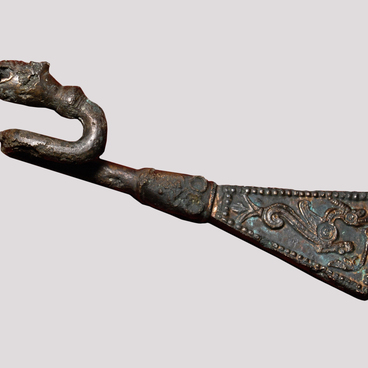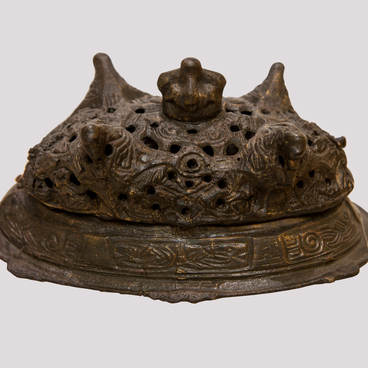The gem of the Smolensk State Museum-Reserve numismatic collection is the coin of the early Middle Ages — the golden solidus of the Byzantine Emperor Alexander. In the 10th century, the gold solidus was the main coin of the Byzantine monetary system, which included silver miliarense and copper follis. Gold solidus also had other names: byzantines, bezants.
In June 1940, a joint expedition of the Smolensk Regional State Museum and the Smolensk Pedagogical Institute under the leadership of museum worker Kalitina and teacher Andreev carried out planned archaeological excavations at the central settlement of the Gnezdovo archaeological complex. The expedition’s report says: “When cleaning the bottom of the pit, things were found that were part of the burial inventory. Near the bones of the skull and near the location of the bones of the chest, on top, lay a silver chain of double rings; below it, in the very middle, a gold pendant coin (solidus of the Emperor Alexander 912-913) was found”.
Emperor Alexander belonged to the Macedonian dynasty, which ruled in Byzantium from 867 to 1056. The Macedonian period left the richest numismatic material for researchers. The coins included portraits not only of emperors, but also of their wives and co-emperors — the ruler’s brothers.
The gold solidus of Emperor Alexander is an almost flat circle with a diameter of 22 millimeters. Its weight — 4.36 grams. The edge of the coin is smooth. The examination, carried out in Smolensk, showed that the solidus was minted from 958th standard gold.
Interestingly, the mosaics from the Hagia Sophia in Constantinople were used as the prototype for the images on the coin. On one side of the coin — the obverse — a paired image of Jesus Christ and Emperor Alexander. On the other — the reverse — Jesus Christ on the throne.
Alexander’s gold solidus is a rare coin. Emperor Alexander ruled Byzantium for only thirteen months. Consequently, the issue of coinage was short.
At the time of the scientific publication of the find in 1945, the Gnezdovo solidus was only the sixth in the world.
In June 1940, a joint expedition of the Smolensk Regional State Museum and the Smolensk Pedagogical Institute under the leadership of museum worker Kalitina and teacher Andreev carried out planned archaeological excavations at the central settlement of the Gnezdovo archaeological complex. The expedition’s report says: “When cleaning the bottom of the pit, things were found that were part of the burial inventory. Near the bones of the skull and near the location of the bones of the chest, on top, lay a silver chain of double rings; below it, in the very middle, a gold pendant coin (solidus of the Emperor Alexander 912-913) was found”.
Emperor Alexander belonged to the Macedonian dynasty, which ruled in Byzantium from 867 to 1056. The Macedonian period left the richest numismatic material for researchers. The coins included portraits not only of emperors, but also of their wives and co-emperors — the ruler’s brothers.
The gold solidus of Emperor Alexander is an almost flat circle with a diameter of 22 millimeters. Its weight — 4.36 grams. The edge of the coin is smooth. The examination, carried out in Smolensk, showed that the solidus was minted from 958th standard gold.
Interestingly, the mosaics from the Hagia Sophia in Constantinople were used as the prototype for the images on the coin. On one side of the coin — the obverse — a paired image of Jesus Christ and Emperor Alexander. On the other — the reverse — Jesus Christ on the throne.
Alexander’s gold solidus is a rare coin. Emperor Alexander ruled Byzantium for only thirteen months. Consequently, the issue of coinage was short.
At the time of the scientific publication of the find in 1945, the Gnezdovo solidus was only the sixth in the world.

